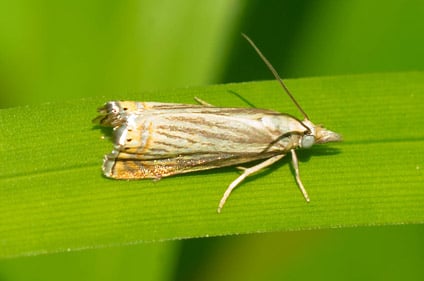Most lawn moths have been a problem on nearly all species of grasses. The family Pyralidae consist of over 20 species, however one of the more important pests across the US and on the west coast fall into the genus Crambus. This species is different than that of the more tropical Herpetogramma commonly found in Florida.
Adult sod webworms are tan or buff colored and about ½ to ¾ inches long. They have sensory projections that extend forward from the tip of the head, giving them a snout like appearance.
Adults store their wings back at rest, giving them a very narrow profile. Sod webworm moths are generally less active during the day but can be seen flying short distances if they are disrupted. This is a common sight when mowing.
Through the evening hours, moths can bee seen flying in a zig-zag pattern just above the turf surface as the females drop eggs in a random pattern. Eggs hatch, and larvae will create a silk-lined tunnel into the soil or thatch layer.
Adults do not damage turf, but the larvae do. They will feed at night initially, skeletonizing turf leaves when younger and shearing off full leaves near the base as they mature. Areas of damage can be easily confused with drought stress or other issues. Upon closer inspection, plants will be chewed off at ground level. You may be able to notice random clippings and green fecal pellets.
To be completely certain, a detergent "soak test" may be in order. Mixing a couple of tablespoons of dishwashing liquid with 2 gallons of water, then drenching the edges of the affected areas should yield some larvae. Most dishwashing soaps are fine, but lemon-scented ones are sometimes more effective.
Crambus will feed on most turfgrasses but really prefer bentgrasses and bluegrasses. Endophyte enhanced ryegrass and tall fescues, along with most warm season grasses, are far less susceptible.
The challenge comes with effective control. Sod webworms typically will have 2 to 4 generations per year depending on weather conditions. Warmer areas particularly on the west coast can easily see 3 to 4 generations.
Cultural management strategies include maintaining proper irrigation and thatch control. Some have had limited success with biological methods or soft chemistries. Chemical means of control should only take place after sufficient scouting. If upon conducting the soak test you find more than 5 larvae per square yard on stressed turf and 15 per square yard in healthy lawns, it will be time to take action.
Most synthetic pyrethroids (the "thrins") will be labeled. If these products have been chosen, they should be applied late in the afternoon, and not watered or mowed for 48 hours. Preventative treatments include Dinotefuran (Zylam), Clothianidin (Aloft or Arena), and Acelepryn.
Learn more on the University of California Agriculture and Natural Resources website. Reach out to the Ewing Technical Services Team with any questions.




